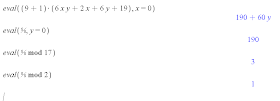To see what Beta(t) does first look at the truth table read across as rows 1 0 0 1, this is the binary number 9, so we have:
First look at the function at x=0 and y = 0, the percent sign means maple uses the last result in place of the percent sign:
In general this Beta function at t produces the 0-15th truth tables for comparing x and y. So to get the truth table that reads across by rows as 1 1 0 0, that is 12 in binary so you would look at B(12) at x = 0..1 and y = 0..1
**Explanation**
Note that the function in x,y over x=0..1 and y=0..1 is:
19*t+19 for t = 0..15:
19
38
57
76
95
114
133
152
171
190
209
228
247
266
285
304
These numbers above mod 17
2
4
6
8
10
12
14
16
1
3
5
7
9
11
13
15
Then the above mod 2:
0
0
0
0
0
0
0
0
1
1
1
1
1
1
1
1
The other four squares in the matrix go 0000111100001111, 0011001100110011, and 0101010101010101
so you get every combination in order...for example the 13th place in each of these four binary numbers is:
1,1,0,1 or 1101 which is the number 13 in binary...






